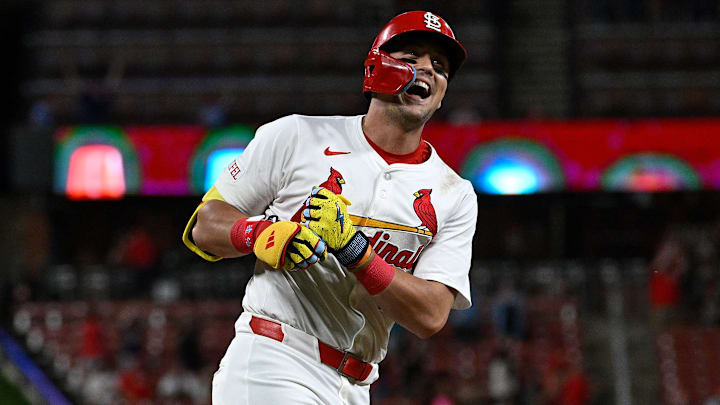At this year's trade deadline, the St. Louis Cardinals followed through on their original plan. While rumors surrounding their players with multiple years of team control began to fly leading up to the deadline, the Cardinals opted to hold on to players like Brendan Donovan, Alec Burleson, Lars Nootbaar, Nolan Gorman, and Ivan Herrera. Each of these players has at least two years of team control left, and they're all still with the team.
Reports leading up to the deadline and those after the deadline indicated that the Cardinals were looking to be "blown away" by offers for these controllable position players. Brendan Donovan, Ivan Herrera, and Alec Burleson were probably the most attractive pieces of this bunch, but Nootbaar and Gorman received ample interest as well according to reports.
St. Louis exited the trading period down three relievers in Ryan Helsley, Steven Matz, and Phil Maton. They added six prospects of varying ages and skill levels as a result, a necessary infusion of young talent to the farm system. John Mozeliak and company also opted to hold on to reliever JoJo Romero, much to the chagrin of fans.
Romero has had an exceptional season, and he has another year of control after 2025. He's now the lone southpaw in the bullpen for manager Oliver Marmol. Romero could have fetched a decent haul at the deadline given the price of controllable pitching, but having a veteran reliever, particularly a lefty, is key to a club's relief corps.
A week before the deadline, president of baseball operations John Mozeliak spoke with Tom Ackerman about the various people who were going to be involved with the trade deadline. "I would just say (Chaim Bloom's) part of the team," said Mozeliak. "The way we have it set up is everybody has a voice in what we do, and he's one of the voices. You know, there are some things where if it was dramatically a very black-and-white issue that was going to affect the future, obviously I would loop him into a different level than just a voice."
Bloom, considering he's the POBO of the future, should have a say on the future direction of the organization. Players under team control and prospects coming back should definitely be reviewed by Chaim considering those players and the roster will be his.
Chaim Bloom was a major contributor in the St. Louis Cardinals' trade deadline dealings this year.
In an interview with Tom Ackerman of KMOX, Mozeliak spoke candidly about his successor, Chaim Bloom, and Bloom's role in the deadline discussions this year.
"A lot of other things were going on at the trading deadline, but it just wasn't to the point where myself, and really even somebody like a Chaim (Bloom), who's starting to think a lot more of the future than I really need to focus on, we just weren't getting the types of offers or felt like we were getting what we needed in return to make those kind of deals."
It had been widely reported that Chaim would be available for consultation throughout the process. If a deal involved any future pieces of the team or prospects coming back, Chaim would absolutely be involved in the discussions. After all, the team is now essentially his to control.
The "other things" that Mozeliak hinted at would almost assuredly be related to those controllable position players. While they were certainly listening to offers on these players, the Cardinals, and Chaim Bloom specifically, were looking for a return package that would be greater than the value they were giving away.
Manager Oli Marmol must now find playing time for these "runway" players on a crowded roster. Nolan Gorman will get the majority of his looks at third base now, but Thomas Saggese is probably deserving of more regular time. Whom Marmol has now is whom he'll have for the rest of the year barring any promotions, demotions, designations, or releases.
Lars Nootbaar, Jordan Walker, and Alec Burleson must battle it out for corner outfield spots with Ivan Herrera as the team's primary designated hitter.
There's a world where Marmol can juggle playing time for Gorman, Burleson, Herrera, Nootbaar, Walker, Saggese, Masyn Winn, and Brendan Donovan while also giving everyone rest. Essentially, everyone plays seven out of eight games in a set. Matchups can be made with handedness, but these eight players can rotate around each other while also getting ample rest.
Mozeliak hinted that the conversations that were started during the trade deadline aren't necessarily over. "Now you flip the script to the offseason, start thinking more about that, and that's where their headspace will be," said Mo. The Cardinals, and Chaim Bloom specifically, could use the offseason to trade from the club's surplus and fill in some needs at the major league and minor league levels.
In a Zoom call with media members, Mozeliak made the club's intentions for the deadline this year clear. "I can say the goal of this trading deadline period was about the future, (and) I don’t think it’s necessarily about the immediate future. It’s about the long-term view of the St. Louis Cardinals.”
Chaim Bloom is the man of the future for the Cardinals, so it's more than reasonable to assume that he shared an equal amount of bargaining power in the moves at this year's trade deadline.
With the deadline now over, Chaim Bloom can begin taking full control of the reins. The players and coaching staff are obviously focusing on winning in the present, but the front office and ownership group are keeping one eye on the future as well. Making the postseason this year would be optimal for the club, but the future is certainly priority #1 for those making the decisions.
